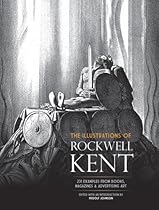The Illustrations of Rockwell Kent: 231 Examples from Books, Magazines and Advertising Art (Dover Fine Art, History of Art)

| Author | : | |
| Rating | : | 4.68 (947 Votes) |
| Asin | : | 0486233057 |
| Format Type | : | paperback |
| Number of Pages | : | 144 Pages |
| Publish Date | : | 2015-09-25 |
| Language | : | English |
DESCRIPTION:
H. The illustrations have been selected by Fridolf Johnson with the collaboration of John F. Rockwell Kent (1882-1971) was probably the most important American book illustrator of the 1920s and '30s. Illustrations for lesser-known works such as A Basket of Poses (1924), Venus and Adonis (1931), and To Thee, America! (1946) are also reproduced. Concentrating on the exceptional works of the '20s and '30s, the volume does include some early material from 1914 and 1915, and a selection of later work from the 1940s and from Rockwell Kent's Greenland Journal (1963).Fridolf Johnson, for many years editor of The American Artist and a respected designer, has written a new introduction tracing Kent's development as an illustrator, captions for the illustrations, and an annotated bibliography of the works represented. Today there is a revival of interest in his illustrations, and this volume brings together for the first time the best of his illustrations from 24 books, as well as magazine art, bookplates, and advertising material — examples in all.Many of his most famous illustrations are included, with several selections each from Candide (1928), Moby Dick (1930), The Canterbury Tales of Geoffrey Chaucer (1930), Salamina (1935), The Complete Works of William Shakespeare (1936), and Goethe's Faust (1941), among others. The
Lawrance Bernabo said Rockwell Kent: premier illustrator of the 19"Rockwell Kent: premier illustrator of the 1920s and 19Rockwell Kent: premier illustrator of the 1920s and 1930s My father had several Modern Library books that were illustrated by Rockwell Kent, including "Moby Dick" and "The Canterbury Tales of Geoffrey Chaucer." For years I have assumed that those memorable plates were wood block prints, which seemed the best explanation for Kent's masterful use of black. 0s" according to Lawrance Bernabo. My father had several Modern Library books that were illustrated by Rockwell Kent, including "Moby Dick" and "The Canterbury Tales of Geoffrey Chaucer." For years I have assumed that those memorable plates were wood block prints, which seemed the best explanation for Kent's masterful use of black. 0s and 19Rockwell Kent: premier illustrator of the 1920s and 1930s My father had several Modern Library books that were illustrated by Rockwell Kent, including "Moby Dick" and "The Canterbury Tales of Geoffrey Chaucer." For years I have assumed that those memorable plates were wood block prints, which seemed the best explanation for Kent's masterful use of black. 0s. My father had several Modern Library books that were illustrated by Rockwell Kent, including "Moby Dick" and "The Canterbury Tales of Geoffrey Chaucer." For years I have assumed that those memorable plates were wood block prints, which seemed the best explanation for Kent's masterful use of black
